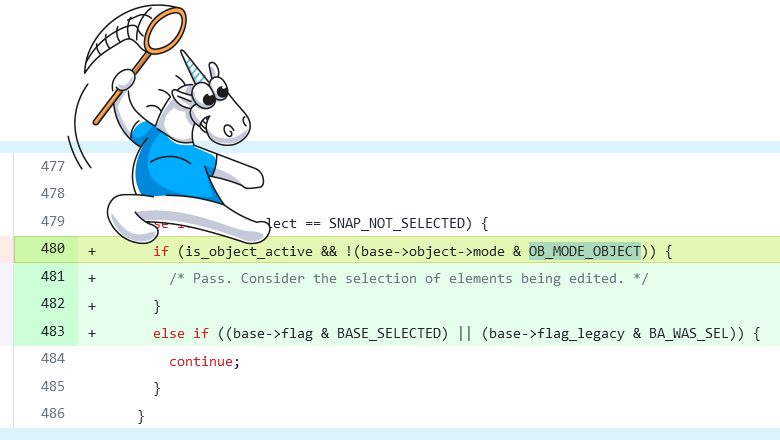
Let's continue with a series of small notes illustrating the PVS-Studio's ability to quickly find new errors in the code. If the analyzer is regularly used, of course :). Today we have another bug in the Blender project.
I monitor the Blender project for fun. Every day I get a PVS-Studio report with warnings related to the new code. Sometimes an error catches my attention and I write a note about it. That's what I'm doing right now :).
I won't give you links to the previous articles, since they are of the same type. With these articles I want to show you that regular use of the static analyzer helps quickly find errors. The earlier the error is found, the lower the cost of fixing it.
This time my attention was caught by two PVS-Studio warnings. The analyzer was triggered by one code line:
- [CWE-480] V616: The 'OB_MODE_OBJECT' named constant with the value of 0 is used in the bitwise operation. transform_snap_object.c 480
- [CWE-571] V560: A part of conditional expression is always true: !(base->object->mode & OB_MODE_OBJECT). transform_snap_object.c 480
This is OK. One code bug can be suspicious for several diagnostic rules. We have just the case here:
if (is_object_active && !(base->object->mode & OB_MODE_OBJECT)) {If you've read the analyzer warnings, you already know what's going on. However, if you look at the code without these warnings, it seems completely normal. This code line can go unnoticed during code review.
To understand that the code is incorrect, you need to look at how the named constant is declared in the eObjectMode enumeration:
typedef enum eObjectMode {
OB_MODE_OBJECT = 0,
OB_MODE_EDIT = 1 << 0,
OB_MODE_SCULPT = 1 << 1,
OB_MODE_VERTEX_PAINT = 1 << 2,
OB_MODE_WEIGHT_PAINT = 1 << 3,
OB_MODE_TEXTURE_PAINT = 1 << 4,
OB_MODE_PARTICLE_EDIT = 1 << 5,
OB_MODE_POSE = 1 << 6,
OB_MODE_EDIT_GPENCIL = 1 << 7,
OB_MODE_PAINT_GPENCIL = 1 << 8,
OB_MODE_SCULPT_GPENCIL = 1 << 9,
OB_MODE_WEIGHT_GPENCIL = 1 << 10,
OB_MODE_VERTEX_GPENCIL = 1 << 11,
} eObjectMode;The OB_MODE_OBJECT constant is zero! Let's look at the condition once again:
if (is_object_active && !(base->object->mode & OB_MODE_OBJECT)) {Thus, the result of the bitwise AND (&) operation is always zero. The first analyzer's message warns us about this.
If we apply the "!" operator to 0, we get the following expression:
if (is_object_active && true) {The second analyzer message tells us that the part of the expression is always true.
Most likely, the correct option would look like this:
if (is_object_active && base->object->mode != OB_MODE_OBJECT) {I'm not sure though, I don't understand the Blender's source code well. The analyzer's task is to point out an error. It's up to the developer to decide what to do with it.
Hope you enjoyed this note. Subscribe to my Twitter: @Code_Analysis.
Additional links: